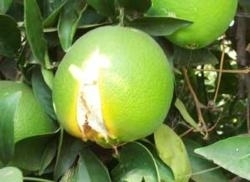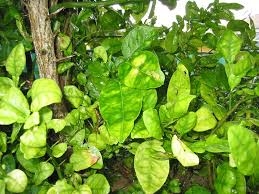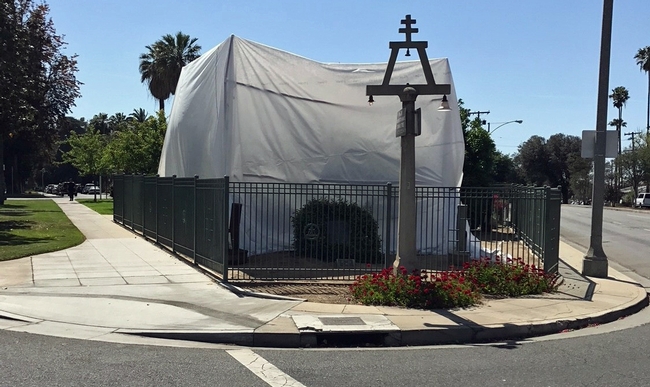
Posts Tagged: navel orange
Ready! Set! Split! Navel Orange Time.
These are hard days for navel oranges. Drought stress. Salt stress due to drought. Then a heat wave in July that messed the trees up. And now we head into a weird fall with maybe rain. Maybe no rain. Maybe a little rain. This is ripe for navel splitting. This time of year when they are starting to build sugar, they are also ripe for splitting.
Years of drought, and a stressed tree are a perfect set up for navel oranges and fruit splitting.
The days have turned cooler and suddenly out of nowhere there is rain. That wonderful stuff comes down and all seems right with the world, but then you notice the navel fruit are splitting. Rats! No, a dehydrated fruit that has taken on more water than its skin can take in and the fruit splits. This is called an abiotic disease. Not really a disease but a problem brought on by environmental conditions.
Fruit splitting is a long-standing problem in most areas where navel oranges are grown. In some years, the number of split fruit is high; in other years it is low. Splitting in navel oranges usually occurs on green fruit between September and November. In some years, splitting may also occur in Valencia oranges but it is less of a problem than in navel oranges.
Several factors contribute to fruit splitting. Studies indicate that changes in weather including temperature, relative humidity and wind may have more effect on fruit splitting than anything else. The amount of water in a citrus tree changes due to weather conditions and this causes the fruit to shrink and swell as water is lost or gained. If the water content changes too much or too rapidly the rind may split. In navel oranges the split usually occurs near the navel, which is a weak point in the rind.
Proper irrigation and other cultural practices can help reduce fruit splitting. Maintaining adequate but not excessive soil moisture is very important. A large area of soil around a tree should be watered since roots normally grow somewhat beyond the edge of the canopy. Wet the soil to a depth of at least 2 feet then allow it to become somewhat dry in the top few inches before irrigating again. Applying a layer of coarse organic mulch under a tree beginning at least a foot from the trunk can help conserve soil moisture and encourage feeder roots to grow closer to the surface.
If trees are fertilized, apply the correct amount of plant food and water thoroughly after it is applied. If the soil is dry, first irrigate, then apply fertilizer and irrigate again.

navel split
Tented Tibbets Tree
The city of Riverside pitched a white tent over the "Parent Navel" orange tree at the intersection of Arlington and Magnolia avenues last week to protect it from the threat of huanglongbing disease, reported Ryan Hagen the Riverside Press Enterprise.
“The Parent Navel is an iconic symbol of Riverside, as it represents the impact the citrus industry had on our economy,” Mayor Rusty Bailey said in a press release issued by the City of Riverside. “Riversiders hold this symbol of our citrus heritage very dear, so it is encouraging to see our parks personnel taking a proactive approach.”
The tree was one of two planted by Eliza Tibbets in 1873, when she received the seedless orange cultivars from Florida by mail. Tibbets cared for the trees and sold budwood to nurseries, which led to extensive plantings of nursery trees cloned from hers.
Huanglongbing disease made its appearance in Riverside last year in residential trees. Officials are working to prevent its spread by controlling Asian citrus psyllid, the insect that can move the disease from tree to tree. Meanwhile researchers are searching for a cure.
The Parent Navel's high value led UC Riverside researchers and city officials to construct the large white barrier.
"It's not beautiful," said Georgios Vidalakis, UC Cooperative Extension specialist and director of the citrus clonal protection program at UC Riverside. "It's obstructing the tree from public view, and we apologize for that. But the risk from not doing that is catastrophic."

navel Washington in Riverside
Satsumas and Navels - Too Late?
There have been some complaints about satsuma mandarin fruit having problems. These are prone to a rind/skin/peel breakdown when the fruit is not picked promptly. It's not clear what the cause is - wet winter, warm winter - but it is less of a problem if the fruit is picked when it is mature. A lot of the time in southern California, satsumas will develop good flavor and sweetness, but for lack of cool weather, they don't turn bright orange, a hallmark of the fruit. So growers will leave the fruit on longer, hoping for color, but the fruit becomes over mature, and more susceptible to breakdown. This weakening of the peel then opens it up to infection by fungi, such as Alternaria. In warm winters, the peel matures more rapidly and is more susceptible. Early maturing varieties like ‘Okitsuwase' are especially prone to breakdown later in the season, since their rind matures earlier. They end up being a mess, as can be seen in the photo below.
Navels can have a similar problem in these winters with erratic rainfall. Common wisdom is you don't irrigate in the winter, right? Wrong. With no, low and widely spaced rain events, the tree roots dry out, and rewet with rain. Navels are building their sugar in the winter and they become suction balls for water as the sugar increases. The fruit will continue to grow as the tree takes up water. When the roots run out of water, and then are suddenly rewetted during this period, the fruit can suck up water so rapidly that the skin cant expand fast enough and will split. So this is what happens with uneven irrigation or rainfall this time of year. One of those abiotic problems in citrus.

satsuma rind breakdown

split navels
What Damaged the Citrus this Winter? Frost? Herbicide?
Something hit the citrus trees of Riverside in late December 2017. Some vandal spraying herbicide? It was too widespread. It was all over town, orchards and backyards. It was on the north and east sides of trees. It didn't happen in Ventura or Santa Barbara. It probably happened to a lot of other plant species, but our correspondent had eyes only for citrus.
It sure looks like it could have been a cold, freezing wind, but on closer consultation with our Citrus Specialist, Peggy Mauk who also directs the Agricultural Operations at UC Riverside – it was the demon wind. The Satan Wind. The Santa Ana that dried out the trees that had not gotten sufficient water to cool themselves and had dried out on the windward side of the tree and orchard. Burned, in effect. This is the side of the orchard that dries out the most. It's what's called the “clothes line” effect. The margins that dry first because of the greater exposure to wind, sun and usually lower humidity. In this case, way lower. And by the time the damage was noticed a week later, the winds had been forgotten. Expect more water stress in our future.

citrus dieback 2

citrus santa ana damage 1
Psyllid News Along the California Coast
Task Force ACP-HLB update
HLB update
To date, 232 residential citrus trees in Southern California have tested positive for the HLB bacterium. All have been, or are being, removed. Most were in neighborhoods in LA and Orange counties. Three of the trees were in Riverside, and although they were residential trees, the resulting 5-mile radius quarantine for HLB is affecting a few growers in Riverside and San Bernardino counties.
The latest HLB quarantine map with the running tally of HLB detections in the state can be found at the Citrus Insider website: https://citrusinsider.org/maps/. The maps are updated every week.
Tree removal
As HLB detections increase and spread closer to commercial citrus, it is a good time to consider removing any citrus trees that are unloved, uncared for, or not worth the time and resources required to protect them from ACP and HLB. Untreated citrus can serve as a reservoir for ACP and possibly the disease HLB, increasing the risk to other citrus in the area. The Citrus Matters ACT NOW program may be able to assist with tree removal at little or no charge to you. Find more information at: https://citrusmatters.cropscience.bayer.us/commercial-grower/act-program. Or if you need referrals for tree removal services, contact Sandra or Cressida.
ACP-HLB program meetings
The California Citrus Pest & Disease Prevention Committee (CPDPC) is made up of growers and other representatives of the citrus industry, working with the California Department of Agriculture (CDFA) and others. The CPDPC is funded in large part by grower assessments and steers the statewide effort to protect our citrus from ACP and HLB. The full committee meets every other month, with subcommittees meeting in between. All committee and subcommittee meetings are public and open to anyone to attend or listen remotely via computer or phone. Agendas for upcoming meetings and minutes from previous meetings are posted on the CDFA website: https://www.cdfa.ca.gov/citruscommittee/.
Coastal citrus representative needed for CPDPC
There is an opening for a grower representative from the coast to serve on the CPDPC. Be a part of deciding how grower funds are spent to protect our industry. Details can be found here: https://www.cdfa.ca.gov/egov/Press_Releases/Press_Release.asp?PRnum=17-069.
Santa Paula crew boss workshop
On Wednesday, Nov. 29, the Citrus Pest & Disease Prevention Program and California Citrus Mutual are hosting a free train-the-trainer workshop in Santa Paula. This Spanish-only workshop for crew bosses, ranch managers, etc., focuses on preventing human-aided spread of ACP and HLB. It has been approved by the Department of Pesticide Regulation for 2 hours of continuing education in the "other" category. For details see:
https://citrusinsider.org/2017/11/santa-paula-crew-boss-workshop/#more-2956
Feel free to contact your ACP-HLB grower liaisons if you have any questions or need assistance:
Cressida Silvers
(805) 284-3310
and
Sandra Zwaal
(949) 636-7089

HLB symptoms

